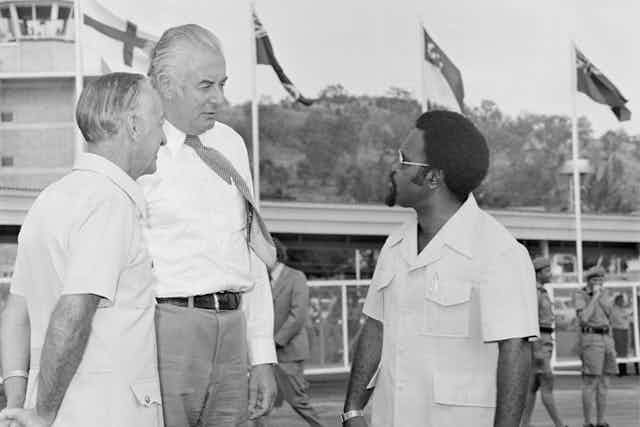September 16 marks the 40th anniversary of the establishment of the sovereign nation of Papua New Guinea. Celebrations are being held throughout the country.
It is worth remembering that Australia was the country that granted independence to Papua New Guinea. For almost 70 years, Australia maintained colonial rule over the eastern half of New Guinea. Unfortunately, this fact is largely absent in contemporary discussions of relations between the countries.
When Australia’s “colonial” history is mentioned, it almost always refers to the period 1788-1901. Little attention is given to Australia’s 20th-century empire of Papua New Guinea and Nauru.
The newly federated Australia assumed control over the British colony of Papua (the south-eastern portion of the island) in 1906. After the first world war, the League of Nations granted Australia control of some of Germany’s colonial possessions under the mandate system. This included German New Guinea, leaving Australia in charge of the entire eastern half of New Guinea, along with the adjacent islands.
Australian colonial rule differed in the separate “territories” of Papua and New Guinea. In Papua, Hubert Murray administered in keeping with British traditions, which were rooted in notions of racial and cultural superiority. In New Guinea, there was a much greater emphasis on profit, with indigenous labour employed in conditions of near-slavery.
This system was broken by the Japanese invasion of New Guinea during the second world war. At this time, New Guinea entered the Australian imagination, through the Australian defeat of the Japanese. This could not have been achieved without the support from the indigenous “fuzzy wuzzy angels”.
It is important to remember that these events took place on Australian territory. Contemporary descriptions of the fighting give little sense of this fact. Instead, they prefer to show that the Allied victories in New Guinea helped to prevent attacks on Australia itself.
Postwar ‘modernisation’ model imposed
Australia quickly reasserted its control over Papua and New Guinea following the war. Under the auspices of the United Nations, Australia was expected to promote the “political, economic, social and educational advancement” of the indigenous population. “Development” became the key word for the colonial administration.
This resulted in the steady introduction of development programs that were in keeping with attitudes of the time. Central to this policy was the attempt to establish a modern society along the lines of “Western”, democratic, capitalist states. Papua New Guinea was a prime example of the ways that colonialism and post-war ideas of modernisation interacted.

A crucial part of this policy was the introduction of a legislative council throughout the 1960s. In reality, this marked the implementation of Australia’s own system of government as a necessary step towards the granting of independence. This resulted in what observers of the early period of independence have referred to as “too pure a form of democracy”.
The imposition of Australian ideas created problems in the years immediately following independence. Leaders sought to find a balance between continuing the Australian policies and finding a new course that reflected the tenuous sense of Papua New Guinean identity.
The results were not always successful. Economic problems combined with unrest in places like Bougainville challenged the government in Port Moresby. The ethnic diversity of Papua New Guinea sat uneasily with the Australian insistence on granting independence to a single, united country.
Refugee policy exploits an unequal relationship
As a part of the granting of independence, Australia pledged to continue providing substantial amounts of aid to Papua New Guinea. Australian governments have stood by this pledge. In the 2015-16 budget, Papua New Guinea is the largest recipient of Australian aid.
In recent times, the offshore processing of asylum seekers has dominated Australia’s relations with its two former colonies, Papua New Guinea and Nauru. Yet the connection between Australia’s history as a colonial power and contemporary refugee policy has been largely overlooked.
Mention of Australian colonialism was absent in the 2013 announcements of then-prime minister Kevin Rudd’s “Pacific solution”. It has remained absent despite increased controversy over conditions both in Papua New Guinea and Nauru.
Critics of Australian refugee policy referred to the “neo-colonial” nature of the relationship between Australia and Papua New Guinea. Such criticism suggests that the post-1975 period has been one of a “master and servant” relationship. While this is a valid point, what has been lacking is a detailed discussion of the period prior to 1975.
Looking forward, it is vital to move away from the colonial dynamic in Australian relations with Papua New Guinea. But forgetting this history will make it much more likely that the “master-servant” dynamic will persist. In celebrating the 40 years of Papua New Guinean independence, we must be careful not to forget what preceded it.

